
Nawab of Awadh
Encyclopedia
 |
||
The Nawab
Nawab
A Nawab or Nawaab is an honorific title given to Muslim rulers of princely states in South Asia. It is the Muslim equivalent of the term "maharaja" that was granted to Hindu rulers....
of Awadh is the title of rulers who governed the state of Awadh
Awadh
Awadh , also known in various British historical texts as Oudh or Oude derived from Ayodhya, is a region in the centre of the modern Indian state of Uttar Pradesh, which was before independence known as the United Provinces of Agra and Oudh...
in India
India
India , officially the Republic of India , is a country in South Asia. It is the seventh-largest country by geographical area, the second-most populous country with over 1.2 billion people, and the most populous democracy in the world...
in the 18th and 19th century. The Nawabs of Awadh originated form Persia
Establishment
As the Moghul power declined and the emperors lost their paramountcy and they became first the puppets and then the prisoners of their feudatories, so Awadh grew stronger and more independent. Its capital city was FaizabadFaizabad
City of Faizabad , previous capital of Awadh, is the headquarters of Faizabad District and a municipal board in the state of Uttar Pradesh, India, situated on the banks of river Ghaghra . Faizabad has a twin city of Ayodhya, which is considered to be the birthplace of Rama...
.
Of all the Muslim states and dependencies of the Mughal empire
Mughal Empire
The Mughal Empire , or Mogul Empire in traditional English usage, was an imperial power from the Indian Subcontinent. The Mughal emperors were descendants of the Timurids...
, Awadh had the newest royal family. They were descended from a Persian
Persian people
The Persian people are part of the Iranian peoples who speak the modern Persian language and closely akin Iranian dialects and languages. The origin of the ethnic Iranian/Persian peoples are traced to the Ancient Iranian peoples, who were part of the ancient Indo-Iranians and themselves part of...
adventurer called Sa'adat Khan, originally from the city of Nishapur
Nishapur
Nishapur or Nishabur , is a city in the Razavi Khorasan province in northeastern Iran, situated in a fertile plain at the foot of the Binalud Mountains, near the regional capital of Mashhad...
. There were many Khurasanis in the service of the Mughals, mostly soldiers, and if successful, they could hope for rich rewards. Burhan ul Mulk Sa'adat Khan proved to be amongst the most successful of this group. In 1732, he was made governor of the province of Awadh. His original title was Nazim
Nazim
A nazim is the coordinator of cities and towns in Pakistan. Nazim is the title in Urdu of the chief elected official of a local government in Pakistan, such as a district, tehsil, union council, or village council....
, which means Governor
Governor
A governor is a governing official, usually the executive of a non-sovereign level of government, ranking under the head of state...
, but soon he was made Nawab
Nawab
A Nawab or Nawaab is an honorific title given to Muslim rulers of princely states in South Asia. It is the Muslim equivalent of the term "maharaja" that was granted to Hindu rulers....
. In 1740, the Nawab was called Wazir
Vizier
A vizier or in Arabic script ; ; sometimes spelled vazir, vizir, vasir, wazir, vesir, or vezir) is a high-ranking political advisor or minister in a Muslim government....
or vizier
Vizier
A vizier or in Arabic script ; ; sometimes spelled vazir, vizir, vasir, wazir, vesir, or vezir) is a high-ranking political advisor or minister in a Muslim government....
, which means Chief Minister
Chief Minister
A Chief Minister is the elected head of government of a sub-national state, provinces of Sri Lanka, Pakistan, notably a state of India, a territory of Australia or a British Overseas Territory that has attained self-government...
, and thereafter he was known as the Nawab Wazir. In practice, from Sa'adat Khan onwards, the titles had been hereditary, though in theory they were in the gift of the Mughal emperor, to whom allegiance was paid. A nazar, or token tribute, was sent each year to Delhi
Delhi
Delhi , officially National Capital Territory of Delhi , is the largest metropolis by area and the second-largest by population in India, next to Mumbai. It is the eighth largest metropolis in the world by population with 16,753,265 inhabitants in the Territory at the 2011 Census...
, and members of the imperial family were treated with great deference; two of them actually lived in Lucknow
Lucknow
Lucknow is the capital city of Uttar Pradesh in India. Lucknow is the administrative headquarters of Lucknow District and Lucknow Division....
after 1819, and were treated with great courtesy.
Inclination towards British
Achieving a certain degree of independence from the Moghuls in Delhi did not, unfortunately, mean that the Nawabs could rule entirely as they pleased. They had merely exchanged one master for another. The British, in the form of the East India CompanyEast India Company
The East India Company was an early English joint-stock company that was formed initially for pursuing trade with the East Indies, but that ended up trading mainly with the Indian subcontinent and China...
based in Calcutta, had long looked with predatory eyes at the wealth of Awadh. Excuses for interference in the province were not hard to find. The most catastrophic from the Awadh point of view came when Shuja-ud-Daula
Shuja-ud-Daula
Shuja-ud-Daula was the Subedar Nawab of Oudh from 5 October 1754 to 26 January 1775, and the son of Muhammad Nasir.Though a minor royal, he is best known for his key roles in two definitive battles in Indian history - the Third Battle of Panipat which ended Maratha domination of India, and the...
invaded Bengal
Bengal
Bengal is a historical and geographical region in the northeast region of the Indian Subcontinent at the apex of the Bay of Bengal. Today, it is mainly divided between the sovereign land of People's Republic of Bangladesh and the Indian state of West Bengal, although some regions of the previous...
, and actually briefly held Calcutta. But British military victories at Plassey in 1757 and Buxar
Buxar
Buxar district is one of the thirty-eight districts of Bihar state, India. The district headquarters are located at Buxar.-Mythology:This place was also known as "Siddhashram", "Vedgarbhapuri", "Karush", "Tapovan", "Chaitrath", "VyaghraSar", "Buxar" in ancient history. The History of Buxar dates...
in 1764 utterly routed the Nawab. When peace was made, Awadh had lost much land. But the enemies became friends, on the surface anyway, and the Nawab Wazir was extolled in the British Parliament as the Chief native allay of the East India Company in all India.
The Nawabs surrendered their independence little by little over many years. To pay for the protection of British forces and assistance in war, Awadh gave up first the fort of Chunar
Chunar
Chunar छुनर شُنَر, located in Mirzapur District of Uttar Pradesh state, India, is an ancient town. The railway tracks passing through Chunar leads to major destinations of India, including Howrah, Delhi, Tatanagar and Varanasi. National Highway number 7 also passes through Chunar...
, then the districts of Benares and Ghazipur
Ghazipur
Ghazipur , or Ghazipur City, previously spelt Ghazeepore, is a city/town and a municipal corporation and headquarter of Ghazipur district in the state of Uttar Pradesh, India. It is the administrative headquarters of Ghazipur Division and Sub-division...
, then the fort at Allahabad
Allahabad
Allahabad , or Settled by God in Persian, is a major city of India and is one of the main holy cities of Hinduism. It was renamed by the Mughals from the ancient name of Prayaga , and is by some accounts the second-oldest city in India. It is located in the north Indian state of Uttar Pradesh,...
; all the time the cash subsidy which the Nawab paid to the Company grew and grew.
In 1773, the fatal step was taken by the Nawab of accepting a British Resident at Lucknow, and surrendering to the Company all control over foreign policy. Soon the Resident, however much he might defer ceremonially to the Nawab, became the real ruler.
Move of capital
Asaf-ud-Daula, son of Shuja-ud-Daula, moved the capital from FaizabadFaizabad
City of Faizabad , previous capital of Awadh, is the headquarters of Faizabad District and a municipal board in the state of Uttar Pradesh, India, situated on the banks of river Ghaghra . Faizabad has a twin city of Ayodhya, which is considered to be the birthplace of Rama...
to Lucknow
Lucknow
Lucknow is the capital city of Uttar Pradesh in India. Lucknow is the administrative headquarters of Lucknow District and Lucknow Division....
in 1775 and made it one of the most prosperous and glittering cities in all India. It is said, he moved because he wanted to get away from the control of a dominant mother. On such a thread did the fate of the great city of Lucknow depend!
Nawab Asaf-ud-Daula was a generous and sympathetic ruler, an inveterate builder of monuments and a discriminate patron of the arts. He built the Bara Imambara
Bara Imambara
Bara Imambara is an imambara complex in Lucknow, India, built by Asaf-ud-daulah, Nawab of Lucknow, in 1784. It is also called the Asafi Imambara.Bara means big, and an imambara is a shrine built by Shia Muslims for the purpose of Azadari...
with its intricate bhul-bhulayya and adjoining mosque, primarily to create employment for his subjects during a time of drought. The Rumi Darwaza also testifies to his architectural zeal.
Relations with Maratha
Relations of Nawab with Maratha was somewhat opportunistic , in 1752 Maratha saved Oudh from Rohilla for a grant of 30lacs from Nawab. The maratha also seek the transfer of Important Religious places of Hinduism, such as Kashi, Benaras, and Allahabad after ignoring them for few years Nawab ceded to Maratha demand and transfer these cities to Maratha in 1757. In 1772 after overrunning Rohillakhand Maratha proceed towards Oudh to capture whole of Oudh , Nawab made frantic calls to British officers in Bengal for his help, British officers knew that Nawab can act like a Puppet whereas Maratha are more dangerous enemy for British company, 20,000 british troops under Sir Robert Barker were sent to Guard Oudh along with Nawab own Army, By then Maratha has penetrated deep into Oudh till Ram Ghat, seeing the british forces along with Nawab Maratha decided maturely to Withdraw from Oudh, In 1772 British Company declare Oudh a buffer state to protect it from Maratha, British troops become protector of Oudh and its Nawab. British company decided to use Oudh as a barrier protection from Maratha, in 1765 Oudh was declared buffer state but Maratha were able to win the districts of Allahabad and Kara, this represents the loophole in British contention of declaring Oudh as a buffer state, the regular help of British in Oudh matters reduced Nawab to just a puppet in British Hands the reason for this was the Maratha Threat unable to fend off Maratha on its own Nawab took help of British and thus reduced his state into British protected state.The heavy dependence of Nawabs on British security reduced the State of Oudh into a tributary of British company, Nawab hired British troops both for internal security and for external security from Maratha at a heavy subsidy this degraded the value of Nawab and the state passed onto British company easily.
The British interference
His son, Wazir AliWazir Ali Khan
Wazir Ali Khan was the fourth nawab wazir of Oudh from 21 September 1797 to 21 January 1798, and the son of Muhammad Nasir.-Life:...
, was the one who most regretted his grandfather's acceptance of a British resident at Lucknow. In 1798, the Governor-General removed him from the throne, on the excuse that there was doubt as to whether he was a true son of Asaf-ud-Daula, but more probably because he was displaying tendencies to independence. They put Asaf's brother, Sadat Ali Khan, on the throne. Sadat Ali Khan, though economical in fiscal management, was nevertheless an enthusiastic builder and commissioned many grand palaces, including Dilkusha
Dilkusha Kothi
Dilkusha Kothi is the remains of an eighteenth-century house built in the English baroque style in the quiet Dilkusha area of Lucknow in India. Today there are only a few towers and external walls as a monument, though the extensive gardens remain...
, Hayat Baksh and Farhat Baksh, as well as the famous Lal Baradari. Hereafter the dynasty had to look to Calcutta rather than to Delhi to settle the succession.
The assassination of a British Resident in 1798 in Benares by the deposed Wazir Ali gave further excuse for interference, and Lord Wellesley (brother of the Duke of Wellington) was just the man to exploit it. By the treaty of 1801, the Nawab had to give up his own army, and pay heavily for a British-led one in its place. The southern doab (Rohilkhand
Rohilkhand
Rohilkhand is a region of northwestern Uttar Pradesh state of India.Rohilkhand lies on the upper Ganges alluvial plain and has an area of about 25,000 km²/10,000 square miles...
) was ceded, and the remainder of the district of Allahabad and other areas became part of British India. In thirty years, Awadh had lost half its territory to the British.
The Nawab demanded in return for these concessions that he should have a free hand in governing his remaining territory, unchecked by the advice or interference of the British. But in this, he was badly handicapped by the fact that he had to rely on British troops to enforce his orders. Wellesley had another trick up his sleeve: a clause of the treaty by which the Nawab under- took to establish a system of administration "by the advice of and acting in conformity to the counsel of the officers of the Honourable Company" which should be conducive to the prosperity of his subjects. It seemed a harmless clause, but was to be the means by which the British eventually annexed Awadh.
The golden age
From 1819 onwards, things ran their course in Avadh. Sadat Ali being gathered to his fathers, GhaziGhazi-ud-Din Haider
Ghazi-ud-Din Haider was the last nawab wazir of Oudh from 11 July 1814 to 19 October 1818 and first King of Oudh from 19 October 1818 to 19 October 1827.-Life:...
his son, sat on the musnud, the throne, and took the cognomen "ud-Din", implying Defender of the Faith. He was formally invested with the title of King by the British, though ironically the proclamation of kingship coincided with a period of almost complete dependence on the British. He lent two millions of rupees to the British feringhee for the Nepal War, and at its close got the Nepalese Terai, a marshy forest extending along the foot of the Himalayas in liquidation of half the debt. Some might have thought it a poor bargain, but in fact the Terai eventually produced some very valuable timber.
Ghazi-ud-Din was a good monarch, responsible for much building and public works of all kinds, and he paid due attention to the administration of justice. He built the Mubarak Manzil and Shah Manzil as well as Hazari Bagh, in which he introduced Lucknow society to the sport of animal contests for the first time
However, his son Nasir-ud-Din
Nasiruddin Haider
Nasir-ud-din Haidar was the second King of Oudh from 19 October 1827 to 7 July 1837.-Life:He was the son of Ghaziuddin Haider....
who succeeded to the throne, had an attachment to the English, not founded upon those things the English would like to be admired for justice, liberty, democracy but upon their dress, their eating habits and, more unfortunately, the drinking habits of the more disreputable element of English adventurer with whom he surrounded himself.
Nasir-ud-Din, despite such a temperament, was a popular monarch, who was responsible for the construction of an astrological center, Tarunvali Kothi. Equipped with sophisticated instruments, it was entrusted to the care of a British astronomer. When he died there was another disputed succession and the British insisted on Muhammad Ali, another son of Sadat Ali, being enthroned. Muhammad Ali
Muhammad Ali Shah
Muhammad Ali Shah was the third King of Oudh from 7 July 1837 to 17 May 1842.-Life:Muhammad Ali Shah was son of Saadat Ali brother of Ghaziuddin Haider and uncle of Nasiruddin Haider....
was a just and popular ruler and under him, Lucknow regained its splendour for a brief spell. He was however sorely troubled by rheumatism. He died in 1842 and his son Amjad Ali
Amjad Ali Shah
Amjad Ali Shah was the fourth King of Oudh from 17 May 1842 to 13 February 1847.- Life :He was son of Muhammad Ali Shah...
succeeded, a man more inclined towards matters religious and spiritual, leading to the neglect of governance.
Annexation by British
Amjad Ali was succeeded by Wajid Ali ShahWajid Ali Shah
Wajid Ali Shah was the fifth King of Oudh, holding the position from 13 February 1847 to 7 February 1856....
, poet, singer, avid patron of the arts and lover of Lucknow. Of him it was written, "He is entirely taken up in the pursuit of his personal gratifications. He has no desire to be thought to take any interest whatever in public affairs and is altogether regardless of the duties and responsibilities of his high office. He lives exclusively in the society of fiddlers, eunuchs and women: he has done so since his childhood, and is likely to do so till his last."
This portrait of Wajid Ali Shah
Wajid Ali Shah
Wajid Ali Shah was the fifth King of Oudh, holding the position from 13 February 1847 to 7 February 1856....
was used to justify British annexation of Awadh. If the charges of mismanagement levied against Wajid Ali Shah were true, the British were as much responsible for this as the Nawab. They were more in control of the administration and finances of Awadh since the 1780s than the Nawab. In addition, Awadh had been impoverished by the incessant cash demands of the British on the Nawab.
The excuse at last came for the British to invoke that clause of the 1801 Treaty. And the Governor General in 1856, Lord Dalhousie, was just the man to do it. Awadh was annexed, Wajid Ali Shah shipped off to virtual imprisonment in Matiyaburj in Calcutta and, though this was not on the British program, the stage set for the greatest rebellion to date against their power in India.
Nawabs of Awadh (1680-1856)
| Portrait | Titular Name | Personal Name | Birth | Reign | Death |
|---|---|---|---|---|---|
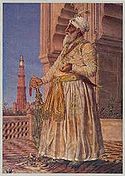 |
Burhan ul Mulk Sa'adat Khan |
Saadat Ali Khan I | 1680 | 1722–1739 | 1739 |
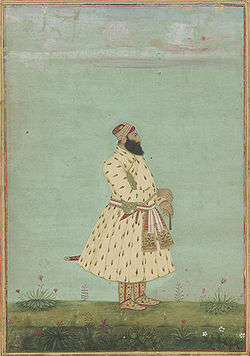 |
Abul-Mansur Khan Safdar Jung |
Muhammad Muqim Safdarjung Safdarjung was the Subadar Nawab of Oudh from 19 March 1739 to 5 October 1754.-Life:Safdarjung was born as Muhammad Muqim in Khurasan, Persia and migrated to India in 1722.-Career:... |
1708 | 1737–1753 | 1754 |
| Shuja-ud-Daula |
Jalal-ud-din Haider Abul-Mansur Khan Shuja-ud-Daula Shuja-ud-Daula was the Subedar Nawab of Oudh from 5 October 1754 to 26 January 1775, and the son of Muhammad Nasir.Though a minor royal, he is best known for his key roles in two definitive battles in Indian history - the Third Battle of Panipat which ended Maratha domination of India, and the... |
1732 | 1753–1775 | 1775 | |
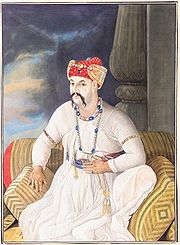 |
Asaf-ud-Daula |
Muhammad Yahya Mirza Amani Asaf-Ud-Dowlah Asaf-Ud-Daula was the nawab wazir of Oudh from 26 January 1775 to 21 September 1797, and the son of Shuja-ud-Dowlah, his mother and grandmother being the begums of Oudh, whose spoliation formed one of the chief counts in the charges against Warren Hastings.-Life:A contemporary chronicler describes... |
1748 | 1775–1797 | 1797 |
| Asif Jah Mirza | Wazir Ali Khan Wazir Ali Khan Wazir Ali Khan was the fourth nawab wazir of Oudh from 21 September 1797 to 21 January 1798, and the son of Muhammad Nasir.-Life:... |
1780 | 1797–1798 | 1817 | |
| Yamin-ud-Daula | Saadat Ali Khan II |
1752 | 1798–1814 | 1814 | |
| Rafa'at-ud-Daula Padshah-i-Awadh |
Abul-Muzaffar Ghazi-ud-din Haydar Khan Ghazi-ud-Din Haider Ghazi-ud-Din Haider was the last nawab wazir of Oudh from 11 July 1814 to 19 October 1818 and first King of Oudh from 19 October 1818 to 19 October 1827.-Life:... |
1769 | 1814–1827 | 1827 | |
 |
Nasir-ud-din Haidar Shah Jahan |
Abul-Mansur Qutb-ud-din Sulaiman Jah Nasiruddin Haider Nasir-ud-din Haidar was the second King of Oudh from 19 October 1827 to 7 July 1837.-Life:He was the son of Ghaziuddin Haider.... |
1827 | 1827–1837 | 1837 |
| Abul Fateh Moin-ud-din | Muhammad Ali Shah Muhammad Ali Shah Muhammad Ali Shah was the third King of Oudh from 7 July 1837 to 17 May 1842.-Life:Muhammad Ali Shah was son of Saadat Ali brother of Ghaziuddin Haider and uncle of Nasiruddin Haider.... |
1769 | 1814–1827 | 1827 | |
| Najm-ud-Daula Abul-Muzaffar Musleh-ud-din | Amjad Ali Shah Amjad Ali Shah Amjad Ali Shah was the fourth King of Oudh from 17 May 1842 to 13 February 1847.- Life :He was son of Muhammad Ali Shah... |
1801 | 1842–1847 | 1847 | |
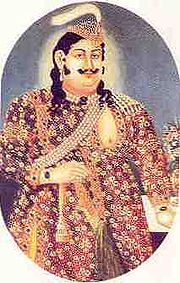 |
Abul-Mansur Mirza | Wajid Ali Shah Wajid Ali Shah Wajid Ali Shah was the fifth King of Oudh, holding the position from 13 February 1847 to 7 February 1856.... |
1822 | 1847–1856 | 1887 |
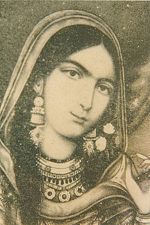 |
Begum Hazrat Mahal |
Muhammadi Khanum Begum Hazrat Mahal Begum Hazrat Mahal , also known as Begum of Awadh, was the first wife of Nawab Wajid Ali Shah.-Queen of Awadh:Her maiden name was Muhammadi Khanum and she was born at Faizabad, Awadh, India. She was a courtesan by profession and had been taken into the royal harem as a Khawasin, after being sold by... |
' | 1879 | |
| Birjis Qadr Birjis Qadra Berjis Qadr was the son of Wajid Ali Shah and was last, Padshah-e Awadh, Shah-e Zaman.-External links:* * * *... |
Ramzan Ali |
1845–1893 | 1893 |
See also
- List of Nawabs of Awadh
- Begum Hazrat MahalBegum Hazrat MahalBegum Hazrat Mahal , also known as Begum of Awadh, was the first wife of Nawab Wajid Ali Shah.-Queen of Awadh:Her maiden name was Muhammadi Khanum and she was born at Faizabad, Awadh, India. She was a courtesan by profession and had been taken into the royal harem as a Khawasin, after being sold by...
- List of Shi'a Muslims dynasties

